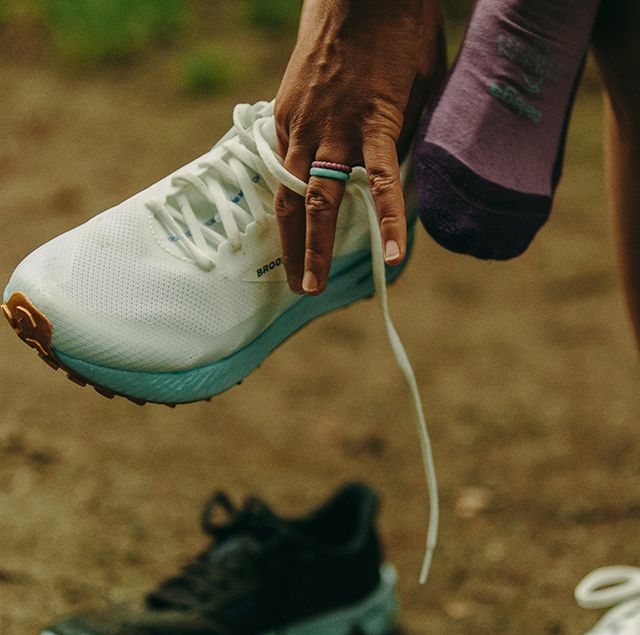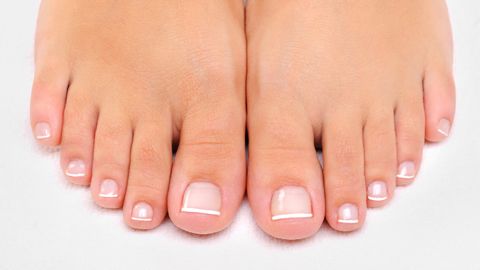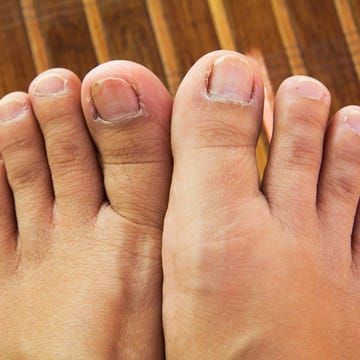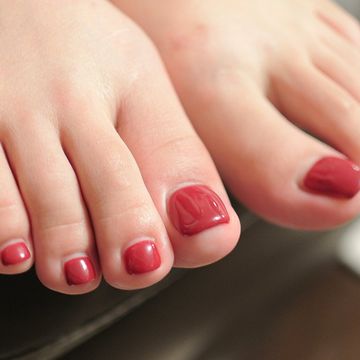- Black toenails in runners are often caused by repetitive trauma, which can result from running or from wearing any type of ill-fitting footwear.
- Keeping your toenails short, sizing up a half size in shoes, or wearing a thinner sock can help prevent black toenails from occurring in the first place.
- In mild cases, no treatment is needed, and the black nail will simply grow out. But if you’re in a lot of pain, your doctor can drain the blood from your nail, which relieves the pressure.
Both a bane to runners and—in some strange way—a badge of honor, the black toenail, or subungual hematoma, is actually blood collecting underneath your nail. It can occur from acute or chronic injury, explains Jordan Metzl, M.D., a sports medicine doctor at the Hospital for Special Surgery in New York City.
The chronic repetitive trauma can range from mild (think: a small, painless, black-and-blue discoloration beneath the nail) to severe (large, bloody blisters between nail and nail plate), adds podiatric surgeon Jacqueline Sutera, D.P.M.
→ Get the best tips to always run strong. Sign up for Runner’s World+ today!
Here’s what you need to know to spot the signs that a black toenail is coming, how to prevent it, and ways to treat the issue.
Causes of Black Toenails
The most common culprit for black toenails is repetitive trauma, which can result from running or from wearing any type of ill-fitting footwear. If a black nail crops up shortly after a workout or a day spent in too-tight or too-loose shoes, this is likely the cause.
Repetitive trauma ranges from mild (think: a small, painless, black-and-blue discoloration beneath the nail), to severe (large, bloody blisters between your nail and nail plate), explains Sutera. Dropping a heavy object (say, a dumbbell) onto your foot can burst the blood vessels under your nail bed and cause blood to pool underneath, too.
But other issues besides trauma can cause black toenails as well.
Fungal infections—like athlete’s foot—can spread to your toenails and turn them shades of yellow, blue, green, brown, purple, and black, Sutera explains. This range in color is unique to fungus, as is the presence of subungual debris—a chalky white substance that lines the nail bed and often carries a funky odor.
If you think you may have a fungal infection, head to your doctor—he or she can clip and biopsy a portion of your nail to confirm a diagnosis. Treatment options vary depending on the severity of the infection. Mild cases are often addressed with topical medications, while more aggressive fungi require oral medication or even laser treatment.
Subungual melanoma—the most serious form of skin cancer—can also grow underneath your nail bed on the nail plate and cause hyperpigmentation of the skin, Sutera explains. It’s often a slow and painless growth, which makes it especially tricky to catch.
One ominous sign is discoloration that extends beyond the nail and onto the cuticle, says sports podiatrist Lori Weisenfeld, D.P.M. “If you’ve had no incidence of trauma, and your nail is slowly starting to change color—especially if that color goes beyond your nail—you should get it checked out by your doctor,” she advises.
Regularly-pedicured patients should do a quick scan of their toes in between polish changes to catch any new developments, Weisenfeld adds. Everyone should ask their doctors to do a yearly skin check.
Occasionally, dark discoloration of the nail bed is merely a matter of skin tone. Sutera sees this most often in patients of color. “There’s skin underneath your toenails, and just like skin anywhere else on your body, the pigmentation can change over time,” she explains.
Often, this type of discoloration is symmetrical and seen on multiple toes. For example, both of your pinky toes may develop discoloration of a similar size and shape. Another telltale sign: similar coloring underneath your fingernails. These factors can help distinguish this type of benign black nail from more malignant ones, which are usually contained to just one nail. Even so, Sutera recommends getting any new and usual color changes checked by your podiatrist or dermatologist, just to be safe.
How to Prevent Black Toenails
Black toenails are more common in runners who run long or at a high intensity than in those who are just getting started. Still, now is the time to work on tactics to prevent them as you start to ramp up.
A common culprit is repetitive trauma, caused by the motion of running and exacerbated by ill-fitting footwear, like if the top of your shoe rubs against your nail or your toe slams into the end of your shoe.
So keep your toenails short, clipping them regularly, and make sure there’s a thumb-width distance from the tip of your longest toe to the end of your shoe, explains Quinton Yeldell, D.P.M., founder of footcare company Southern Hospitality. Then look for shoes that are wide enough that your forefoot rests comfortably within the shoe without hitting either side of it.
Sizing up a half size in shoes or wearing a thinner sock can help ease the pressure and protect toenails, says Metzl.
How to Treat Black Toenails
Okay, you have a black toenail. Don’t fret. In mild cases, no treatment is needed, and the black nail will simply grow out. But in some cases, the subungual hematoma can cause pain—the more blood under your nail, the more it will hurt, says Metzl.
If this is the case, head to your doctor. He or she can poke a few holes into the nail to drain the blood, which relieves the pressure and will also help save the nail. Prompt action is key here, though: The procedure must be done within the first few days of the injury. So if you feel pain, don’t play the waiting game.
And don’t try to treat it yourself at home, either. This is a procedure that needs to be done at the doctor’s office. Despite what you may hear about it being a DIY trick, attempting this yourself can leave you at risk for infection.
While it may be tempting to hide the discolored toenail with nail polish, think twice before painting it—nail polish does not allow the nail to breathe, and you could risk losing it altogether, says sports medicine physician William O. Roberts, M.D. Reserve that move for special occasions, not everyday wear.
How to Heal Black Toenails
If a black toenail rips off and causes injury, first apply pressure until the bleeding stops. Then apply an antibiotic ointment and cover with a bandage to prevent infection. Do this each day after showering until the wound closes up, which should take about one to two weeks.
But in cases of repeated microtrauma—hitting your nails against the shoes when you run—the nail can simply fall off without any bleeding or open wounds. If that’s the case, you should still use an antibiotic ointment and a bandage to guard against infection. Usually by the time the nail comes off, your nail bed is less sensitive, and the pain should be minor, says Metzl.
Sometimes there is already a new nail growing beneath it. “As long as it doesn’t hurt too much, you should be fine to run,” he says. A new nail should take between six and eight weeks to grow in.

Jenny is a Boulder, Colorado-based health and fitness journalist. She’s been freelancing for Runner’s World since 2015 and especially loves to write human interest profiles, in-depth service pieces and stories that explore the intersection of exercise and mental health. Her work has also been published by SELF, Men’s Journal, and Condé Nast Traveler, among other outlets. When she’s not running or writing, Jenny enjoys coaching youth swimming, rereading Harry Potter, and buying too many houseplants.










